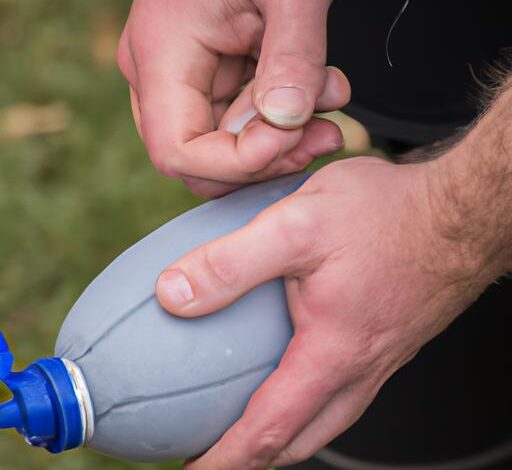How to Pump Up a Rugby Ball Without a Pump

Introduction
Are you ready to tackle the rugby field, only to find yourself without a pump to inflate your ball? Don’t worry, I’ve got you covered! In this article, we’ll explore some ingenious ways to pump up a rugby ball without a pump. A properly inflated rugby ball is crucial for optimal performance and game play, so let’s dive in and discover alternative methods to keep you in the game.
Rugby is a sport that demands precision and control. A properly inflated ball ensures the optimal shape and balance required for accurate passes, powerful kicks, and dependable catches. Without the right pressure, your ball can become unpredictable, affecting your performance on the field. But what if you find yourself without a pump? Don’t let that deflate your spirits – we’ll explore alternative methods to get that ball in perfect shape!
Why a Pump is Essential for Inflating a Rugby Ball
When it comes to inflating a rugby ball, a pump is more than just a convenience – it’s essential. A pump allows you to achieve the correct pressure, enabling the ball to maintain its shape and balance. The right pressure ensures accurate passes, controlled kicks, and consistent bounces, providing you with the confidence to excel on the rugby field.
Without a pump, you might be tempted to resort to other means of inflation, such as blowing air directly into the ball. However, this method can be inconsistent and unpredictable, leading to an unevenly inflated ball that hampers your performance. It’s crucial to explore alternative methods to ensure you have a reliable way to pump up your rugby ball when a pump is not readily available.
Stay tuned for the upcoming sections, where we’ll delve into alternative methods and DIY techniques that will have you back in action, inflating your rugby ball like a pro – even without a pump! Let’s explore the possibilities and keep the game going strong.
Why a Pump is Essential for Inflating a Rugby Ball
Achieving the Correct Pressure
To truly understand why a pump is essential for inflating a rugby ball, we must first grasp the importance of achieving the correct pressure. Rugby balls have specific pressure requirements, typically ranging from 9 to 10.5 pounds per square inch (psi). This optimal pressure allows the ball to maintain its shape, ensuring proper grip, bounce, and flight characteristics.
Without a pump, it becomes challenging to achieve the precise pressure needed for optimal performance. Blowing air into the ball with your mouth might seem like a quick fix, but estimating the pressure accurately is nearly impossible. Overinflating the ball can result in a rock-hard surface, making it difficult to handle and control. On the other hand, underinflated balls lack the necessary weight and shape, affecting your ability to pass, kick, and catch accurately.
Maintaining Shape and Balance
A properly inflated rugby ball maintains its shape and balance, providing stability and consistency during gameplay. The unique oval shape of a rugby ball allows for precise handling and passing. However, if the ball is underinflated, it becomes squishy and loses its form, making it difficult to grip and control. This can lead to fumbles, missed catches, and inaccurate passes, costing you valuable opportunities on the field.
Additionally, an underinflated ball affects its balance. A balanced ball ensures consistent flight patterns when kicked or thrown. It allows for accurate trajectory and predictable bounces, giving you the confidence to make strategic plays. Without the correct pressure, the ball’s balance is compromised, leading to unpredictable movements that can throw off your game.
In conclusion, a pump is essential for inflating a rugby ball to achieve the correct pressure, maintain its shape, and ensure proper balance. Without a pump, you risk playing with an underinflated or overinflated ball, which can significantly impact your performance. Now that we’ve established the importance of a pump, let’s explore alternative methods to keep your rugby ball in top shape, even when a pump is not available.
Alternative Methods for Inflating a Rugby Ball without a Pump
When you find yourself in a pinch without a pump, fear not! There are alternative methods that can save the day and get your rugby ball inflated and ready for action. Let’s explore a few options:
Using a Bicycle Pump as an Alternative Option
If you happen to have a bicycle pump lying around, you’re in luck! This versatile tool can come to the rescue when you need to inflate your rugby ball. Simply attach the ball needle to the end of the pump, insert it into the ball’s valve, and start pumping. The process may take a bit longer compared to a dedicated ball pump, but with a little patience, you’ll have your ball inflated to the perfect pressure.
Utilizing a Ball Needle and a Compressed Air Source
Another alternative method involves using a ball needle and a compressed air source, such as an air compressor or a can of compressed air. Attach the ball needle to the air source, insert it into the ball’s valve, and release the compressed air. Be cautious and avoid over-inflating the ball, as this can affect its shape and performance. Monitor the pressure as you go, ensuring you achieve the desired inflation level.
Exploring the Possibility of Borrowing a Pump from Someone Nearby
In times of need, don’t hesitate to reach out to your fellow rugby enthusiasts or teammates. If you find yourself without a pump, there’s a good chance someone nearby might have one to lend. Sports clubs, gyms, or even friends and family who share your passion for rugby may have a pump available. Don’t be shy to ask for help – the rugby community is known for its camaraderie, and borrowing a pump is a simple solution to keep the game going.
With these alternative methods at your disposal, you can inflate your rugby ball even without a pump. Don’t let the lack of equipment deflate your game. Stay tuned as we dive deeper into DIY techniques that can help you pump up a rugby ball using common household items. Let’s keep the ball rolling!
DIY Techniques to Inflate a Rugby Ball without a Pump
When you find yourself without a pump, fear not! There are clever DIY techniques that can come to your rescue and help you inflate your rugby ball. Let’s explore two effective methods that require simple household items.
1. Inflating with a Water Bottle
You might be surprised to learn that a regular water bottle can be transformed into a makeshift pump for your rugby ball. Here’s a step-by-step guide to get you started:
- Find a clean and empty plastic water bottle.
- Remove the cap and cut off the bottom of the bottle.
- Insert the cut end of the bottle into the valve of the rugby ball, ensuring a tight fit.
- Squeeze the bottle, forcing air into the ball.
- Repeat the process until the ball reaches the desired level of inflation.
This method allows you to control the airflow and gradually inflate the ball to the proper pressure. It may require a bit of effort, but it’s a reliable DIY solution when a pump is unavailable.
2. Using a Straw or Pen Barrel
If you don’t have a water bottle on hand, don’t worry – there’s another technique you can try. Grab a straw or a pen barrel and follow these steps:
- Find a sturdy straw or a pen barrel that can fit into the valve of the rugby ball.
- Insert one end of the straw or pen barrel into the valve, ensuring a tight seal.
- Blow air into the other end of the straw or pen barrel, inflating the ball.
- Repeat the process until the ball reaches the desired inflation level.
While this method may require a bit more lung power, it can be an effective way to get your rugby ball ready for action without a pump.
Remember, these DIY techniques are temporary solutions and may not provide the same level of inflation precision as a pump. Exercise caution and avoid over-inflating the ball as it can impact the game’s performance and potentially damage the ball.
Stay tuned as we explore more tips and precautions to ensure a successful inflation process without a pump.
Precautions and Tips for Inflating a Rugby Ball without a Pump
When it comes to inflating a rugby ball without a pump, there are a few precautions and tips to keep in mind. By following these guidelines, you can ensure a successful inflation process and maintain the longevity of your ball.
5.1 Ensuring Cleanliness and Hygiene while Using Alternative Methods
Before attempting to inflate your rugby ball using alternative methods, it’s essential to ensure cleanliness and hygiene. Make sure to wash your hands thoroughly before handling the ball to avoid transferring dirt or germs onto its surface. Additionally, if you’re using unconventional items like a water bottle or straw as makeshift pumps, ensure they are clean and free from any contaminants that could potentially impact the ball’s condition.
5.2 Monitoring the Pressure and Avoiding Over-Inflation
While inflating your rugby ball without a pump, it’s crucial to monitor the pressure carefully. Over-inflating the ball can lead to excessive pressure, affecting its shape, balance, and performance. Use a pressure gauge, if available, to keep track of the inflation process. Remember, a properly inflated rugby ball should feel firm but not overly tight. Take breaks during the process to allow the ball to settle and adjust accordingly to achieve the desired pressure.
5.3 Taking Care while Handling the Ball to Prevent Damage
When using alternative methods to inflate your rugby ball, it’s important to handle it with care to prevent any potential damage. Avoid sharp or rough surfaces that could puncture or scrape the ball’s outer surface. Be gentle when inserting makeshift pumps like straws or pen barrels, ensuring you don’t force them too forcefully into the valve. Treating the ball with care will help maintain its integrity and prolong its lifespan, allowing you to enjoy countless games with your trusty rugby companion.
By following these precautions and tips, you can confidently inflate your rugby ball without a pump and get back in the game. Remember, cleanliness, pressure monitoring, and careful handling are the keys to success. Now that you’re well-prepared, let’s move on to the exciting DIY techniques that will have your ball pumped up and ready for action in no time!
Conclusion
Inflating a rugby ball without a pump may initially seem like a daunting task, but with the alternative methods we’ve explored, you’ll never have to worry about being without a pump again. Remember, a properly inflated rugby ball is the key to optimal performance on the field.
We’ve discussed various alternative methods, such as using a bicycle pump, a ball needle and compressed air, or even borrowing a pump from a nearby friend or teammate. Additionally, we’ve explored DIY techniques like using a water bottle, straw, or pen barrel as makeshift pumps. These methods may not be as convenient as a pump, but they can certainly save the day when you’re in a pinch.
However, it’s important to exercise caution and follow some precautions while inflating your rugby ball without a pump. Ensure cleanliness and hygiene, monitor the pressure to avoid over-inflation, and handle the ball with care to prevent damage.
By incorporating these alternative methods into your rugby routine, you’ll always be prepared to pump up your ball, regardless of the situation. So, the next time you find yourself without a pump, don’t let it deflate your game. Embrace the resourcefulness and ingenuity that rugby players are known for and keep the ball inflated and ready for action.
Remember, practice makes perfect, and mastering the art of inflating a rugby ball without a pump will only enhance your skills on the field. So, get out there, pump up that ball, and let nothing stand in the way of your rugby success!
Conclusion: So above is the How to Pump Up a Rugby Ball Without a Pump article. Hopefully with this article you can help you in life, always follow and read our good articles on the website: pet.top5dalat.com





